Abstract
Molecular communication (MC) represents a paradigm shift in communication technologies, extending beyond traditional electromagnetic methods by incorporating advances in nanotechnology, biotechnology, and communication theory. This innovative approach holds promise for groundbreaking applications in diverse fields such as medicine, military operations, and environmental monitoring. MC employs molecules to carry and transmit data. In concentration-encoded molecular communication (CEMC), information is represented through the concentration levels of the transmitted molecules. In this study, we introduce a novel method named time-hopping concentration-position shift keying (TH-CPSK), designed to facilitate multiple access within MC networks. The TH-CPSK method encodes information based on the position of the transmitted molecular concentration, significantly enhancing the accuracy of data transmission by reducing interference in MC channels. Numerical simulations reveal that an increase in the number of users adversely affects communication performance. Furthermore, our findings indicate that augmenting the number of hops improves communication performance at transmitter-receiver distances of 1 cm and 2 cm. Conversely, at a distance of 3 cm, performance degradation is observed, attributed to the increased complexity. Therefore, it is important to carefully select the number of hops considering the molecular channel’s characteristics. Overall, TH-CPSK can enhance the efficiency and reliability of CEMC systems, offering a significant step forward in the realization of MC’s potential applications.
1. Introduction
Molecular communication (MC) [1,2,3] has emerged as a groundbreaking method of communication inspired by biological mechanisms observed in nature. By leveraging chemical signals for the transmission of information, MC presents itself as a viable alternative to conventional electromagnetic (EM) wave-based methods, offering new perspectives and solutions in the field of communication technology [4,5]. As an interdisciplinary domain, MC encompasses the integration of nanotechnology, biotechnology, and communication technology, comprising components such as transmitters, channels, and receivers. Its reliance on the chemical movement of molecules facilitates effective communication in environments with substantial spatial limitations, exemplifying its utility in nanoscale communication, such as intra- and inter-cellular communication [6]. This enables the establishment of molecular nanonetworks within the human body [7,8], which could revolutionize applications such as targeted drug delivery [9]. Other applications of MC exist in the fields of medicine [10] and the Internet of Bio-Nano Things [11,12]. Unlike EM communication, which depends on external energy sources like batteries and can consume considerable power, MC operates through chemical interactions between molecules, optimizing energy efficiency. This characteristic is particularly beneficial in applications requiring operation at a microscopic scale or where prolonged battery life is paramount. Furthermore, MC’s biocompatibility makes it a promising option in scenarios where EM methods face challenges, including applications within human bodies [13].
Regarding communication, MC exploits modulation techniques that leverage the unique physical characteristics of molecules for data transmission, namely concentration, type, timing, and space [1,14]. Concentration-based modulation represents a method whereby data encoding is achieved through the quantitative manipulation of the amount of molecule emitted by the transmitter. This method facilitates the conveyance of information via the control of the molecular concentration at the receiver [15,16]. In contrast, type-based modulation utilizes various molecular species as discrete informational entities, wherein each molecule type embodies a distinct bit or signal, permitting the transmission of complex data through the amalgamation of different molecular species. Timing-based modulation [17], another critical technique, governs the temporal emission of molecules, encoding data within specific time intervals by modulating the emission timing of molecules across communication slots, where the sequence and presence or absence of molecular emissions are instrumental in the information transfer process. Spatial-based modulation, particularly relevant in molecular multiple-input multiple-output configurations [18,19], employs multiple spatially distinct molecular emitters within a single transmitter apparatus. This method encodes information via the spatial distribution of molecular emissions, facilitating data recovery at the receiver through the interpretation of signals received from different paths [14].
From the perspective of communications engineering, MC is still in its infancy, with the identification of an optimal modulation technique for encoding data onto transmitting particles as its foundational challenge. Concentration shift keying (CSK), analogous to on-off keying in EM communications, prevails as the predominant modulation method in MC [15,20,21,22,23]. In CSK, no molecules are emitted for bit ‘0’, and some concentration of molecules is emitted to represent bit ‘1’. However, CSK faces a problem called inter-symbol interference (ISI), where some molecules from one transmission linger in the channel and interfere with the next transmission. This is a major issue that can lower the performance of CSK-CEMC systems. To deal with ISI, pulse-position modulation (PPM) is often used in EM communication, where the timing of pulses carries the information. Similar to PPM, concentration-position shift keying (CPSK) leverages both the concentration and the spatial position of the molecular signal to reduce the ISI and increase the data rate. However, CPSK still struggles because the signal can shift even without noise, especially as the distance increases, due to the way MC channels work [24]. To tackle this, recent studies have explored the application of machine learning techniques to improve the performance of MC [24,25]. By utilizing machine learning, the complex characteristics of MC channels can be trained, allowing the development of communication strategies that can predict and adapt to changes in the channel, thereby enhancing the performance of CEMC [24].
To achieve a fully functional nanonetwork, multiple nanomachines should be able to communicate simultaneously within a shared medium—a concept known as multiple access (cf., Figure 1). Traditional EM communication systems utilize various multiple access techniques [26], but the unique properties of MC demand novel approaches. CEMC offers a promising pathway by utilizing the concentration of molecules as a means to encode information. However, as the number of devices within an MC system increases, the potential for signal interference and degradation also rises. In this context, multiple access techniques tailored for CEMC can significantly enhance system capacity and reliability. In this paper, we propose a method to realize multiple access within the domain of CEMC by applying the time-hopping concentration-position shift keying (TH-CPSK) scheme to CEMC systems. By leveraging time hopping in conjunction with CPSK, our approach significantly reduces the likelihood of interference and enables higher throughput in densely populated MC networks. In particular, TH-CPSK utilizes multiple spatial positions for signal transmission, thereby mitigating the impact of channel biases or ISI that can dominate a single location. This strategy not only lowers the error probability at each position but also bolsters the system’s resilience to channel variations. In other words, in scenarios where strong interference or channel fading occurs at one hop, TH-CPSK compensates by leveraging other hopping positions.
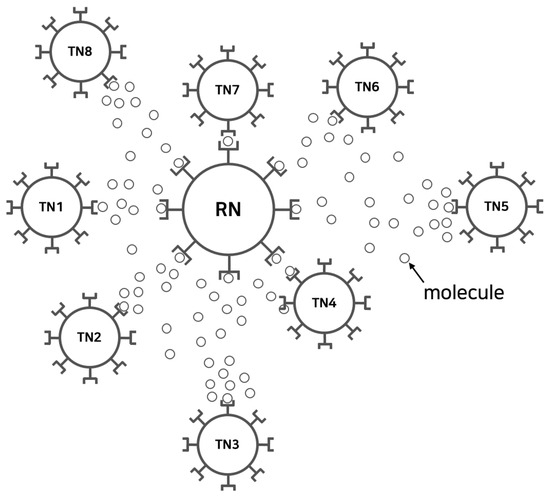
Figure 1.
A multiple access architecture where eight transmitter nanomachines (TNs) are trying to communicate with a receiver nanomachine (RN) at the same time.
The main contributions of this study are as follows. First, we propose the TH-CPSK scheme for CEMC systems in a multiuser MC environment. The TH-CPSK technique operates by modulating the temporal position of the transmitting molecules, which effectively minimizes interference among multiple users by transmitting each user’s signal in an irregular time pattern. Second, we present in detail the mathematical model to implement the TH-CPSK technique. In addition, a free-diffusion MC channel [14,27] is considered. Finally, we evaluate the performance of the TH-CPSK scheme under various communication distances and environmental conditions.
This paper is organized as follows. Section 2 lays the groundwork by detailing the system model for the conventional CPSK scheme. Section 3 introduces our proposed TH-CPSK scheme, including the system model and signal model, and discusses the characteristics of the free-diffusion MC channel. In Section 4, we present the simulation results for the proposed TH-CPSK scheme, comparing its efficacy under various system design parameters. The paper concludes with Section 5.
2. Concentration-Position Shift Keying (CPSK)
Before delving into the specifics of our proposed TH-CPSK system model, it is beneficial to establish a foundational understanding of the conventional CPSK utilized in CEMC [24]. CPSK is a modulation method that encodes information using the concentration position of molecules, drawing parallels to M-PPM prevalent in EM communication, where M is the modulation order. Just as M-PPM encodes data in the position of pulses to minimize ISI, CPSK aims to use the spatial position of molecules for information encoding, where a concentration pulse can be placed in one of the M possible time slots, thereby seeking to mitigate ISI effects. This method underscores the innovative adaptation of concepts from EM communication to the molecular domain, laying the groundwork for advancements such as TH-CPSK.
Figure 2 illustrates a block diagram of a CEMC system employing 4-CPSK, which comprises two nanomachines: a transmitter nanomachine (TN) and a receiver nanomachine (RN). The system utilizes the molecule concentration, denoted as , to encode information. Specifically, the TN sends data bits “01” and “10”, and these are encoded into positions 2 and 3, respectively, each with concentration . Consequently, the transmitted signal, , maintains this constant concentration, , across all symbol intervals. The signal emitted by the TN traverses a free-diffusion channel, characterized by the unimpeded movement of molecules through the medium, often air. This movement is influenced by thermal energy from the environment, leading to random molecular motion and diffusion as a result of collisions with solvent molecules. Upon reaching the RN, the transmitted molecules are subject to a ligand–receptor binding process (LRBP). This process involves the interaction between the ligand molecules, which carry the information, and the RN’s receptors. The collision of ligand molecules with these receptors produces a chemical pulse, facilitating the transmission of information [28,29,30]. Through the LRBP, the received concentrations of molecules, , are measured by the RN’s chemical receptors located on the cell boundary. It is important to note that not all molecules may bind to the receptors during the LRBP, leaving some within the channel and potentially influencing subsequent signal transmissions. The RN employs a probabilistic approach to interpret the concentration data, converting it into a probability value, , which helps identify the position with the highest probability. This process enables the RN to determine the correct symbol position received, demodulate the data, and decode the output bits.
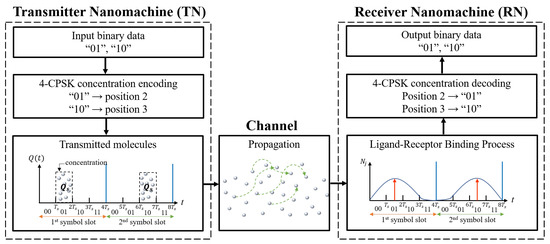
Figure 2.
Block diagram of CPSK-CEMC system with modulation order .
3. Proposed TH-CPSK-CEMC System
In CPSK-CEMC systems, signal shifting, caused by the delay spread characteristics inherent in the MC channel, can lead to errors, even in the absence of external noise. To address this challenge, we introduce the time-hopping concentration-position shift keying (TH-CPSK) modulation technique, which utilizes multiple positions for signal transmission instead of relying on a single position. This method effectively distributes the impact of noise or interference across different positions, thereby reducing the probability of error at any given position. Furthermore, TH-CPSK leverages multiple time slots for signal transmission, diminishing the influence of fading on specific transmission paths. An additional advantage of TH-CPSK is its more efficient utilization of spectrum resources, achieved through time-hopping signal transmission, which optimizes bandwidth use. In particular, the time-hopping mechanism employs multiple positions and thus diminishes interference in a multiuser scenario.
Figure 3 presents a block diagram of a CEMC system, utilizing TH-CPSK with . As shown in the figure, the transmission of data bit “1” is encoded at a concentration of at the second position within each time slot. The signal emanates from the TN and traverses a free-diffusion channel to reach the RN. Upon arrival, the signal, denoted as , can be detected by the RN through the LRBP. However, our analysis primarily examines the efficacy and reliability of the TH-CPSK scheme for multiple access, thus excluding LRBP considerations from this discussion. Instead, we assume a high density of receptors on the RN’s surface, ensuring efficient contact between available molecules and receptors [31,32]. During the decoding phase, a soft decision methodology is employed, aggregating the concentrations at the first and second positions within each time slot. The position exhibiting the higher concentration level is then identified, facilitating the estimated determination of the received symbol position. This process culminates in the decoding of the final output bits at the RN.
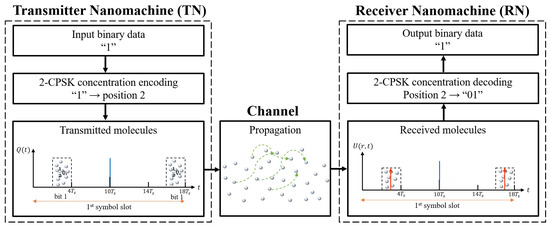
Figure 3.
Block diagram of TH-CPSK-CEMC system with .
3.1. Signal Model
Utilizing M-ary CPSK for N users, the transmitted signal for a given user k can be expressed as [26]
where represents the molecular concentration per , is a normalized concentration shaping function, denotes the frame period, specifies the timing of molecule release, and corresponds to the duration of one period. As shown in Figure 4, the total transmission time, , is structured by segmenting the total available time into frames. Each frame accommodates possible hopping positions for a molecule, calculated as . Consequently, the total transmission time is given by . The TH code is modeled as an independent random variable, taking values such that with equal probability. The TH code provides an additional shift of in order to reduce the collision effect in multiple access settings. Moreover, the frame time is assumed to be an integer multiple of the chip time, that is, . The term indicates the symbol transmitted by the kth user (with ). This introduces an additional shift (), used to distinguish the concentrations carrying bit 0 and bit 1. The above equation captures the essence of TH-CPSK in a multiple access setting, highlighting how each user’s signal is composed and transmitted within the MC network [26].
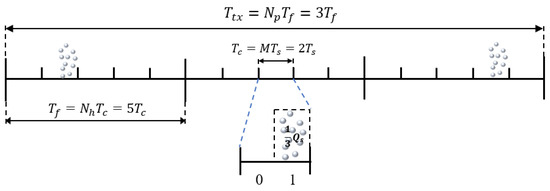
Figure 4.
An example of a simple TH-CPSK signaling structure, where and . The total signal time is divided into three slots, and based on the position of the molecular concentration, corresponding bits are transmitted.
3.2. MC Channel
Channel modeling is a crucial aspect of MC systems, dictating how molecules propagate through various media. In this study, we focus on channels characterized by free diffusion in air media, defined by the channel quantum response. In a free-diffusion channel, the movement of signaling molecules is driven by the concentration gradient and Brownian motion, rather than active transport mechanisms. The channel quantum response captures the dynamic behavior of molecules as they move through the channel. The channel model is given as follows [15,24]:
where is the concentration of molecules at distance r and time t, D represents the diffusion coefficient of the channel in , and r is the distance between the TN and the RN in . The diffusion coefficient, D, depends on the medium of the MC channel [15]. Note that Equation (2) assumes that the concentration of molecules diffuses over time from a point source. In particular, we can observe a Gaussian distribution as a function of time and distance, reflecting the random nature of molecular diffusion.
Figure 5 illustrates the channel quantum response for the diffusion-based MC channel, showing how the concentration of signaling molecules varies over time (t) for different distances (r) from the TN. We can observe that initially, the concentration increases, reaching a peak value before gradually decreasing. The maximum indicates the peak concentration for each distance. As the distance from the transmitter increases, the peak concentration value decreases. This is observed with the highest peak at cm, followed by lower peaks at cm and cm. This trend is consistent with Equation (2), which predicts lower concentrations at greater distances due to the spreading of molecules. In addition, with the decrease in amplitude, we can observe a shift in the received peak concentration. This is due to the channel bias. Particularly, for cm, the delay is at approximately 4 s, and the spread is also high.
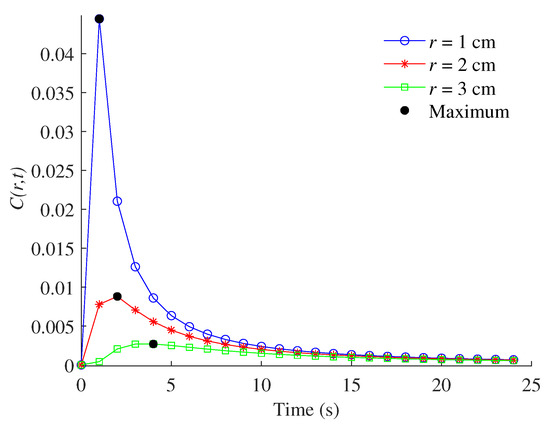
Figure 5.
Channel quantum response for the three distances simulated in this paper.
3.3. Multiuser Interference
In the depicted scenario (cf., Figure 1), multiple TNs are distributed randomly within a short-range environment. The transmitted molecules, when reaching the RN, may lead to multiuser interference. This interference arises when molecules emitted by different TNs arrive at the RN simultaneously and collide. To model this scenario realistically, our study assumes that the distances between each TN and the RN vary randomly, ranging from 1 to 10 . This approach helps simulate a diverse set of conditions reflective of potential real-world applications, where the spatial arrangement of TNs relative to an RN can significantly impact communication performance due to the stochastic nature of molecular diffusion and the potential for multiuser interference.
In our study, to comprehensively understand the dynamics of MC systems within a multiuser context, we focus on modeling the system based on the perspective of a specific user (for example, User 1). The spatial arrangement and relative distances between users play a crucial role in delineating the interference patterns observed within the system. Users positioned closer to the receiver than User 1 have a higher likelihood of their signals arriving earlier, thereby elevating the risk of collision with User 1’s transmitted signal. Conversely, users situated further away than User 1 tend to have their signals reach the receiver later, potentially leading to interference with signals transmitted after User 1’s signal. Consequently, the variations in distances between users intricately influence the temporal distribution of signal reception. In light of this, the received signal for User 1, denoted as , encapsulates the interaction of these factors and can be expressed as follows:
where the first term corresponds to the signal received from User 1, convolved with the channel’s impulse response, , and the second term aggregates the interference caused by all other users, from 2 to N. The symbol ∗ denotes the convolution operation. Equation (3) can be expanded into a more detailed representation, as shown in Equation (4), accounting for the diffusion dynamics, as follows:
where represents the propagation delay of the ith TN signal and D is considered constant throughout the observation period.
3.4. Demodulation
For demodulation, we employ a soft decision decoding method to process signals transmitted via CPSK. Initially, we assign a value for each time slot n and position m. The aggregation of these values across all time slots for a given position is then calculated as follows:
where represents the cumulative value for position m. Subsequently, we identify the position with the highest aggregated value, which indicates the most likely transmitted position. This detected position, denoted as , is determined by the following equation:
In the context of Equation (6), is then compared to the initially transmitted position m. A match between the detected and transmitted positions signifies the successful detection of the transmitted signal. Conversely, any discrepancy is categorized as a detection error, indicating a potential misinterpretation of the transmitted information due to factors such as the MC channel’s effect or multiuser interference.
4. Simulation Results
This section evaluates the symbol error rate (SER) and achievable data rate (ADR) of the proposed TH-CPSK scheme. Our multiuser MC environment considers an MC channel characterized by free diffusion in air with the coefficients presented in Table 1. This implies that the molecules emitted by transmitter nanomachines undertake a random walk, diffusing toward the receiver through Brownian motion. Table 1 also outlines the default parameters used for simulations, applicable unless specified otherwise. The chosen default parameters allow us to maintain consistency with prior research [26], ensuring our results are both comparable and reliable. User 1 is the desired user that we want to receive, and perfect knowledge of its time-hopping pattern , together with ideal synchronization between the TN and RN, is assumed.

Table 1.
Default simulation parameters.
Figure 6 illustrates the SER according to the number of users, N, in the system. The figure compares the SER for two modulation schemes, and , at three different TN-RN distances : 1 , 2 , and 3 . First, we can observe that the SER escalates with an increase in the number of users for all distances and both modulation orders. This is because of the increase in multiuser interference at the RN, where the signals from multiple TNs overlap, making it difficult for the RN to decode the signal from User 1. With more users, the probability of signal overlap increases, which can lead to more frequent and severe multiuser interference. The impact of this interference is more noticeable as the user count grows.
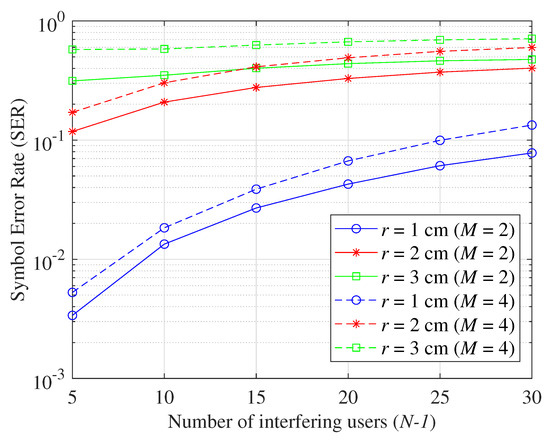
Figure 6.
SER versus number of interfering users for different TN−RN distances.
Second, the SER is directly proportional to the distance between the TN and RN. For both and , the error rate is highest at 3 and lowest at 1 . This trend suggests that at a distance of 3 , the MC channel characteristics become more pronounced, potentially due to a critical point where the channel effects, such as bias, noise, and interference, have a substantial impact on the signal. The distinct rise in errors at 3 , particularly for the scheme, suggests that the channel at this distance is causing significant distortion or loss of information. This could be due to a combination of effects, including diffusion dynamics, molecule degradation, and the time it takes for molecules to reach the RN. Lastly, the system with modulation order exhibits a lower SER compared to . The increased SER of the scheme, which represents more bits per symbol, contributes to a higher probability of error, especially as the number of users grows. To more accurately compare the performance of TH-CPSK, we also evaluated the ADR performance.
Figure 7 examines the ADR across varying distances with an increasing number of interfering users. The data exhibit a decline in the ADR as the user count rises, aligning with the anticipated inverse relationship between the ADR and SER. This is indicative of multiuser interference—as more users try to communicate over the same channel, the chances of signal collision increase, leading to a loss of molecules and a decrease in the ADR. Moreover, the greater the distance the molecules have to travel, the more likely they are to be dispersed or lost in the channel, resulting in fewer molecules reaching the RN. For instance, at a closer range cm), the channel influence diminishes, resulting in a higher ADR. This is because of the reduced likelihood of signal diffusion and loss over shorter distances, which results in more molecules successfully arriving at the RN and thus a higher data rate. Furthermore, for all distances, the ADR for is higher than that for . This suggests that the simpler modulation scheme (lower M) is more robust against the increased path loss and potential interference that come with longer distances or more complex modulation schemes. As M increases, more information can be transmitted per symbol, leading to an increase in data throughput. However, despite the theoretical increase in the amount of data that can be transmitted at , the relatively high SER compared to makes efficient data transmission more challenging in practice. The comparison between modulation schemes with and also shows an expanding ADR gap as r increases.
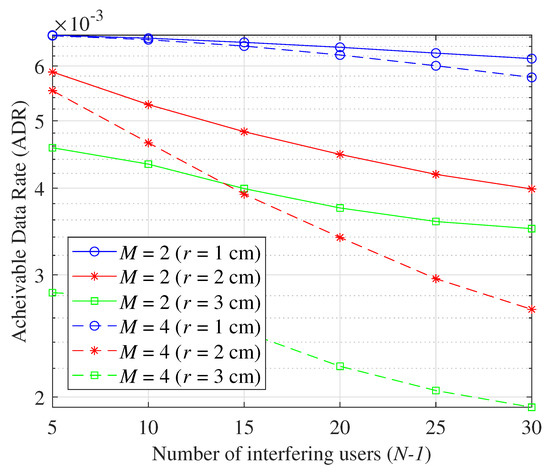
Figure 7.
ADR versus number of interfering users for different TN−RN distances.
Figure 8 demonstrates that the SER decreases as the number of hops, , increases for distances of 1 and 2 for a fixed number of interfering users at five. This is because the increase in reduces the interference at the RN. However, it notably increases slightly for a distance of 3 . This indicates that increasing at shorter distances would decrease the interference in the system. However, at larger distances, the effect of increasing is negligible. This pattern can be explained by the MC channel behavior observed in Figure 5. From the channel model (Equation (2)), it can be seen that concentration depends on the distance r in an inverse exponential manner. Specifically, as r increases, decreases. As shown in Figure 5, for cm and 2 cm, the peak of the CQR occurs at times and 2 s, respectively. This indicates that the molecules quickly reach the receiver, maintaining a high concentration. In addition, the dispersion of the molecules in the channel is less, and the SER decreases with increasing . However, at r = 3 cm, the peak of the CQR is notably delayed at s, with a significant reduction in amplitude. This implies that fewer molecules reach the receiver, and they do so after a long delay. Moreover, the molecules disperse over a wider area as they travel a longer distance, resulting in a diluted concentration by the time they reach the receiver. Therefore, regardless of the increase in , we did not see any improvement in the SER. Therefore, we can say that for r = 3 cm and above, reducing the interference at the receiver does not improve the performance of the SER, making the SER nearly flat.
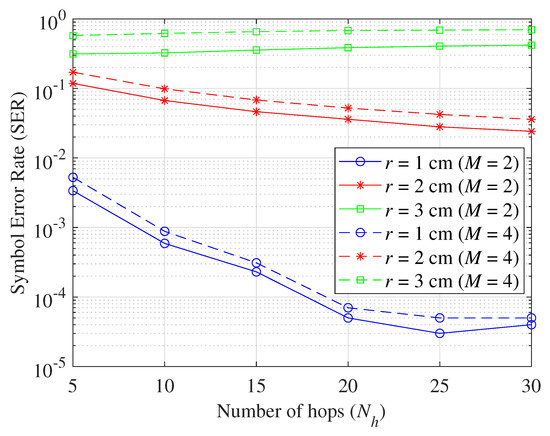
Figure 8.
Comparison of symbol error rate according to the number of hops and TN−RN distances.
Figure 9 depicts a closer look at the SER versus plot for the distance of 3 . We can clearly observe that the SER is indeed showing a slowly increasing trend, suggesting the use of lower-order modulation for greater distances. The slowly increasing SER pattern at cm with increasing in Figure 9 can be explained by the time resources consumed by additional hops. More hops increase the separation between transmitted symbols, leading to further dispersion in the channel. While increasing reduces interference, it also increases the dispersion of transmitted molecules, particularly pronounced at greater distances. This behavior is also observable at cm, where the SER slope is less steep compared to that at cm. Overall, we found that for cm, the precision in detecting the molecule concentration at the RN drops due to channel bias, making it more challenging to accurately discern the signal location. Therefore, at large distances, where channel bias has a significant impact, using fewer hops may reduce errors. In addition, we found that with an increase in , the received signals do not overlap, indicating a reduction in ISI. However, while ISI decreases, the delayed signals are not canceled, leading to errors caused by the delay. In conclusion, as increases, ISI decreases, but the reduction in the number of signal overlap cases leads to an increased error rate. Furthermore, as mentioned above, shows a lower SER at all distances compared to , implying that lower-order modulations are more robust to channel impairments. Altogether, the choice of and M depends on the trade-off between the desired data rate and the robustness against the communication channel.
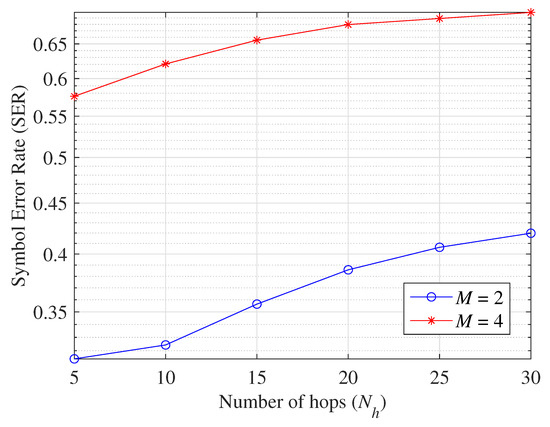
Figure 9.
Symbol error rate according to the number of hops and TN-RN distance, with cm.
5. Conclusions
Molecular communication is an emerging field that combines nanotechnology, biotechnology, and communication technology, offering efficient and biocompatible communication on a nanoscale, in contrast with traditional electromagnetic methods. In this study, multiple access to concentration-encoded molecular communication using TH-CPSK was proposed and analyzed. From the simulation results, we confirmed that errors due to channel complexity tend to increase as the number of interfering users increases. In particular, the error increases rapidly at distances where the channel influence is noticeable, suggesting that it is effective to use fewer pulse positions at certain distances when the channel influence is relatively large. The decline in the achievable data rate as the number of users increases is consistent with this trend of increasing errors, with the data rate being particularly high at distances where the channel has less influence. Therefore, the number of hops must be selected considering the channel-delayed diffusion characteristics, and it is expected that it will be advantageous to apply this scheme in CEMC systems considering the distance between nanomachines. These insights contribute to the advancement of MC applications, marking a step toward more efficient and stable communication system design.
Author Contributions
Conceptualization, S.-Y.J.; methodology, P.S. and S.-Y.J.; software, S.-J.K.; validation, S.-J.K., P.S., and S.-Y.J.; formal analysis, S.-J.K.; investigation, S.-J.K., P.S., and S.-Y.J.; resources, S.-Y.J.; data curation, S.-J.K.; writing—original draft preparation, S.-J.K. and P.S.; writing—review and editing, P.S. and S.-Y.J.; visualization, P.S. and S.-Y.J.; supervision, P.S. and S.-Y.J.; project administration, S.-Y.J.; funding acquisition, P.S. All authors have read and agreed to the published version of the manuscript.
Funding
This work was supported by the 2023 Yeungnam University Research Grant.
Institutional Review Board Statement
Not applicable.
Informed Consent Statement
Not applicable.
Data Availability Statement
Data is contained within the article.
Conflicts of Interest
The authors declare no conflicts of interest.
References
- Farsad, N.; Yilmaz, H.B.; Eckford, A.; Chae, C.B.; Guo, W. A comprehensive survey of recent advancements in molecular communication. IEEE Commun. Surv. Tutor. 2016, 18, 1887–1919. [Google Scholar] [CrossRef]
- Nakano, T. Molecular Communication; Cambridge University Press: Cambridge, UK, 2013. [Google Scholar]
- Nakano, T.; Moore, M.J.; Wei, F.; Vasilakos, A.V.; Shuai, J. Molecular communication and networking: Opportunities and challenges. IEEE Trans. Nanobiosci. 2012, 11, 135–148. [Google Scholar] [CrossRef] [PubMed]
- Akyildiz, I.F.; Brunetti, F.; Blázquez, C. Nanonetworks: A new communication paradigm. Comput. Netw. 2008, 52, 2260–2279. [Google Scholar] [CrossRef]
- Atakan, B. Molecular Communications and Nanonetworks; Springer: New York, NY, USA, 2014. [Google Scholar]
- Bi, D.; Almpanis, A.; Noel, A.; Deng, Y.; Schober, R. A survey of molecular communication in cell biology: Establishing a new hierarchy for interdisciplinary applications. IEEE Commun. Surv. Tutor. 2021, 23, 1494–1545. [Google Scholar] [CrossRef]
- Malak, D.; Akan, O.B. Molecular communication nanonetworks inside human body. Nano Commun. Netw. 2012, 3, 19–35. [Google Scholar] [CrossRef]
- Atakan, B.; Akan, O.B.; Balasubramaniam, S. Body area nanonetworks with molecular communications in nanomedicine. IEEE Commun. Mag. 2012, 50, 28–34. [Google Scholar] [CrossRef]
- Chude-Okonkwo, U.A.; Malekian, R.; Maharaj, B.T.; Vasilakos, A.V. Molecular communication and nanonetwork for targeted drug delivery: A survey. IEEE Commun. Surv. Tutor. 2017, 19, 3046–3096. [Google Scholar] [CrossRef]
- Felicetti, L.; Femminella, M.; Reali, G.; Liò, P. Applications of molecular communications to medicine: A survey. Nano Commun. Netw. 2016, 7, 27–45. [Google Scholar] [CrossRef]
- Akyildiz, I.F.; Pierobon, M.; Balasubramaniam, S.; Koucheryavy, Y. The internet of bio-nano things. IEEE Commun. Mag. 2015, 53, 32–40. [Google Scholar] [CrossRef]
- Lee, C.; Koo, B.H.; Chae, C.B.; Schober, R. The Internet of bio-nano things in blood vessels: System design and prototypes. J. Commun. Netw. 2023, 25, 222–231. [Google Scholar] [CrossRef]
- Al-Helali, A.; Liang, B.; Nasser, N. Novel molecular signaling method and system for molecular communication in human body. IEEE Access 2020, 8, 119361–119375. [Google Scholar] [CrossRef]
- Kuran, M.Ş.; Yilmaz, H.B.; Demirkol, I.; Farsad, N.; Goldsmith, A. A survey on modulation techniques in molecular communication via diffusion. IEEE Commun. Surv. Tutor. 2020, 23, 7–28. [Google Scholar] [CrossRef]
- Mahfuz, M.U.; Makrakis, D.; Mouftah, H.T. On the characterization of binary concentration-encoded molecular communication in nanonetworks. Nano Commun. Netw. 2010, 1, 289–300. [Google Scholar] [CrossRef]
- Mahfuz, M.U.; Makrakis, D.; Mouftah, H.T. A comprehensive study of sampling-based optimum signal detection in concentration-encoded molecular communication. IEEE Trans. Nanobiosci. 2014, 13, 208–222. [Google Scholar] [CrossRef] [PubMed]
- Li, Q. A novel time-based modulation scheme in time-asynchronous channels for molecular communications. IEEE Trans. NanoBiosci. 2019, 19, 59–67. [Google Scholar] [CrossRef] [PubMed]
- Koo, B.H.; Lee, C.; Yilmaz, H.B.; Farsad, N.; Eckford, A.; Chae, C.B. Molecular MIMO: From theory to prototype. IEEE J. Sel. Areas Commun. 2016, 34, 600–614. [Google Scholar] [CrossRef]
- Koo, B.H.; Lee, C.; Pusane, A.E.; Tugcu, T.; Chae, C.B. MIMO operations in molecular communications: Theory, prototypes, and open challenges. IEEE Commun. Mag. 2021, 59, 98–104. [Google Scholar] [CrossRef]
- Okaie, Y.; Nakano, T. Binary concentration shift keying with multiple measurements of molecule concentration in mobile molecular communication. In Proceedings of the Bio-Inspired Information and Communication Technologies: 12th EAI International Conference, BICT 2020, Shanghai, China, 7–8 July 2020; Springer: Cham, Switzerland, 2020; pp. 42–51. [Google Scholar]
- Mahfuz, M.U.; Makrakis, D.; Mouftah, H.T. Concentration-encoded subdiffusive molecular communication: Theory, channel characteristics, and optimum signal detection. IEEE Trans. Nanobiosci. 2016, 15, 533–548. [Google Scholar] [CrossRef]
- Kuran, M.Ş.; Yilmaz, H.B.; Tugcu, T.; Akyildiz, I.F. Interference effects on modulation techniques in diffusion based nanonetworks. Nano Commun. Netw. 2012, 3, 65–73. [Google Scholar] [CrossRef]
- Mahfuz, M.U. Achievable strength-based signal detection in quantity-constrained PAM OOK concentration-encoded molecular communication. IEEE Trans. Nanobiosci. 2016, 15, 619–626. [Google Scholar] [CrossRef]
- Kim, S.J.; Singh, P.; Jung, S.Y. A machine learning-based concentration-encoded molecular communication system. Nano Commun. Netw. 2023, 35, 100433. [Google Scholar] [CrossRef]
- Lee, C.; Yilmaz, H.B.; Chae, C.B.; Farsad, N.; Goldsmith, A. Machine learning based channel modeling for molecular MIMO communications. In Proceedings of the 2017 IEEE 18th International Workshop on Signal Processing Advances in Wireless Communications (SPAWC), Sapporo, Japan, 3–6 July 2017; IEEE: Piscataway, NJ, USA, 2017; pp. 1–5. [Google Scholar]
- Singh, P.; Kim, B.W.; Jung, S.Y. TH-PPM with non-coherent detection for multiple access in electromagnetic wireless nanocommunications. Nano Commun. Netw. 2018, 17, 1–13. [Google Scholar] [CrossRef]
- Arifler, D. Connectivity properties of free diffusion-based molecular nanoscale communication networks. IEEE Trans. Commun. 2017, 65, 1686–1695. [Google Scholar] [CrossRef]
- Pierobon, M.; Akyildiz, I.F. Noise analysis in ligand-binding reception for molecular communication in nanonetworks. IEEE Trans. Signal Process. 2011, 59, 4168–4182. [Google Scholar] [CrossRef][Green Version]
- Einolghozati, A.; Sardari, M.; Fekri, F. Capacity of diffusion-based molecular communication with ligand receptors. In Proceedings of the 2011 IEEE Information Theory Workshop, Paraty, Brazil, 16–20 October 2011; IEEE: Piscataway, NJ, USA, 2011; pp. 85–89. [Google Scholar]
- Mahfuz, M.U.; Makrakis, D.; Mouftah, H.T. Strength-based optimum signal detection in concentration-encoded pulse-transmitted OOK molecular communication with stochastic ligand-receptor binding. Simul. Model. Pract. Theory 2014, 42, 189–209. [Google Scholar] [CrossRef]
- Mahfuz, M.U.; Makrakis, D.; Mouftah, H.T. A comprehensive analysis of strength-based optimum signal detection in concentration-encoded molecular communication with spike transmission. IEEE Trans. Nanobiosci. 2015, 14, 67–83. [Google Scholar] [CrossRef]
- Moore, M.J.; Nakano, T.; Enomoto, A.; Suda, T. Measuring distance from single spike feedback signals in molecular communication. IEEE Trans. Signal Process. 2012, 60, 3576–3587. [Google Scholar] [CrossRef]
Disclaimer/Publisher’s Note: The statements, opinions and data contained in all publications are solely those of the individual author(s) and contributor(s) and not of MDPI and/or the editor(s). MDPI and/or the editor(s) disclaim responsibility for any injury to people or property resulting from any ideas, methods, instructions or products referred to in the content. |
© 2024 by the authors. Licensee MDPI, Basel, Switzerland. This article is an open access article distributed under the terms and conditions of the Creative Commons Attribution (CC BY) license (https://creativecommons.org/licenses/by/4.0/).